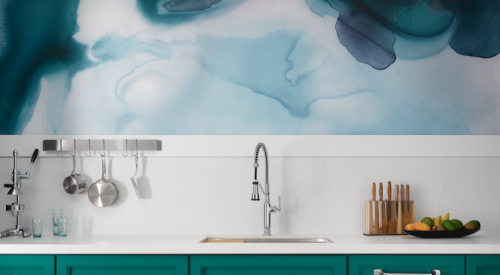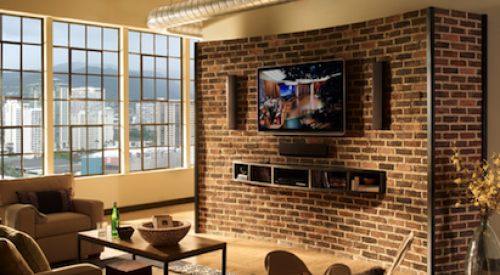|
No matter the size of the home, the kitchen is indisputably the hardest working room in the place. Gone are the days when having plenty of counter and cabinet space was the primary concern for potential home buyers. Top design experts and builders from across the country agree that these days, people expect, and are getting, more performance from their kitchens than ever before.
"Rather than simply functioning as a work area for meal preparation, the kitchen has become much more important as an entertaining space," says Sean Ruck, spokesman for the National Kitchen and Bath Association.
Although it is most often paired visually with the family room, today's kitchen has developed its own identity as a complex and dynamic space designed to play host to a variety of functions — often all going on at the same time. "The kitchen is no longer just an expanded keeping room," says Stephanie Witt, a Certified Master Kitchen and Bath Designer (CMKBD) and founder of Kitchens by Stephanie, a Grand Rapids, Mich.-based full-service design studio. "It really has become the main place in the home where people gather. With today's open floor plans, you simply can't keep guests out of the kitchen."
From providing storage space for food and utensils to handling meal preparation and cleanup, to serving as the social center of the home, a well-designed kitchen must do it all — and look its best at all times.
Manufacturers have responded to consumer demand with a myriad of options not only in appliance design, configuration, and technology, but by also offering countless choices in finishes and materials for everything from countertops, to cabinetry, to fixtures, to flooring.
Treasured islandsFunctionally, there is no element that continues to be more important in the kitchen than the island, according to Paula DenBoer a interior designer with Ashley P. Designs Scottsdale, Ariz. "They're huge. Literally every kitchen that we do features an island of some type," she says.
The workhorse of today's kitchen, the island, not only provides additional counter space, but often includes a food prep sink (sometimes two) and room enough for scaled-down, but handy, appliances such as refrigerated drawers, a mini-freezer, trash compactor as well as a separate cooktop. The island also often doubles as a snack bar with a separate spot in its design dedicated to pull-up seating. Finally, the kitchen island helps to eliminate countertop clutter by providing out-of-sight storage space for small appliances.
"We hide everything that we can in them," says Witt, "so that we can eliminate the more traditional, corner appliance garage that I think can interfere with the visual flow of the counter space."
"Single level islands are the most functional in terms of usable counter space," says CMKBD, Nancy Braamse, of Olde World Cabinetry in Largo, Fla. "But a multi-level island can be wonderful for hiding clutter or what's going on in the kitchen from people in the adjoining rooms."
Hide and seek finishesBraamse, who is also a certified interior designer, says that the popularity of integrated appliances — including refrigerators, dishwashers, and warming drawers, that can be disguised behind panels that match the surrounding cabinetry — "goes hand in hand with the trend toward making the kitchen more suitable as an entertaining space. You really want to disguise pretty much everything that you can, particularly when that appliance is really large like a refrigerator."
Witt agrees that there has been a significant surge in the demand for integrated appliances among her clients. "We have some kitchens where you would be hard-pressed to find all the appliances unless you knew where they were already!"
Still, the commercial-style look of sleek stainless steel appliances remains a popular choice in all markets, Witt says. Manufacturers such as Frigidaire and Sub-Zero have responded to complaints about maintaining the shine of stainless steel and reducing its tendency for collecting fingerprints by offering a variety of premium coatings that offer the same look without the upkeep
High-tech havenManufacturers continue to develop appliances which are increasingly sophisticated in an effort to simplify things for today's on-the-go consumer — virtually transforming the kitchen into the high-tech center of the home. To speed things up, new ovens which feature thermal, convection and microwave cooking modes from manufacturers like General Electric, promise to cook food much faster than a conventional oven.
In response to demand for healthier methods for preparing meals, manufacturers such as KitchenAid, Miele and Gaggenau have introduced convection steam ovens which allow cooked foods to retain more of their nutritional value and eliminate the need for added fats during the cooking process. TIMO has even introduced an oven that features a built-in refrigeration mode which allows frozen meals to be placed in the oven in the morning, kept chilled throughout the day, and then cooked either by a pre-set timer, or controlled remotely by phone, so that a hot dinner will be ready and waiting at the end of the day. Induction cooktops, which provide an alternative to conventional gas or electric versions, use magnetic energy coupled with specially designed stainless steel or cast iron cookware, rather than direct surface heat, to cook foods. Although it has been used for decades in Europe, induction cooking is now gaining attention as an alternative in the U.S. and manufacturers such as Wolf are introducing their own versions to the market.
Braamse is enthusiastic about new drawer-style microwave ovens, which put the appliance at waist height, permitting food to be checked and stirred during the cooking process without having to be removed from the oven. Sharp Electronics offers not only a separate microwave drawer unit, but also a model with its own built-in cooktop, or both combined with a full-size range.
Refrigerators, too, have kept pace with today's new technology by offering better energy efficiency than ever before, multi-zone temperature control capabilities and enough configuration possibilities to match any scenario a kitchen designer can dream up. "The trend is the break up the refrigeration in the kitchen into separate components," says Witt.
Manufacturers offer everything from free-standing models, to fully integrated versions you may not recognize as a refrigerator at all, to counter-height versions designed to be incorporated into an island or butler's pantry.
And specialty appliances including stand alone ice makers, built-in beverage centers, instant hot water dispensers and wine chillers, once found only in the realm of ultra-high-end custom kitchens, are being incorporated in more modestly-priced applications today.
"Wireless internet access has been terrific for incorporating the computer into the kitchen," Braamse says. "We can easily incorporate a notebook computer into an inconspicuous spot using either a flip down screen or pop up from a drawer and give a cook instant access to their archive of recipes or the ability to look them up online."
With the plethora of electronics designed into today's kitchens, even the most technologically-savvy consumers may find themselves challenged when it comes to feeling at home in their kitchen. What do the experts recommend? "With all new appliances there is a learning curve that people face when getting familiar with using them," says Witt. "I advise my clients simplify wherever they can. For example, if they have two ovens, I suggest they choose two that are either the same or, at the very least, from the same manufacturer."
Natural beautyCabinetry not only provides practical storage space in the kitchen but also enhances the décor of the home itself. "It continues to be the single largest expense in the kitchen budget," says Witt. "A rule of thumb for new construction of a custom home is that approximately 10 to 15 percent of the total market value of the house should be allocated for cabinetry." Witt specifies cabinetry from custom manufactures Rutt and Plain & Fancy Custom Cabinetry for her high-end projects and semi-custom cabinets from Medallion Cabinetry for more modest applications.
"While kitchens are becoming more elegant in terms of their finishes," says custom builder, Gordon Gibson, of Santa Monica, Calif., "they're also becoming a lot more fun and eclectic in style."
DenBoer agrees. "There is a lot less color matching when it comes to all of the cabinetry." she says. "Instead, we may use different but complementary finishes to highlight different areas. For example, we may want to accent the island by using a different color finish and even trim style than that used for the perimeter cabinets."
"Cabinets are also becoming simpler in terms of door style and embellishment," Witt says. The most popular finishes are those that permit the natural grain and beauty of the wood to show through.
Because of its tendency to collect everyday clutter, the built-in desk, or organization center, has been permanently banished from today's kitchen. "I have not built a home with a built-in desk in the kitchen in several years, says Tampa, Fla.-based builder, Jay Fechtel. "This function is now handled by creating a separate computer alcove near the kitchen or removing it altogether to the home office."
Top it all off"There are more options for countertops than ever before," Witt says. "Twenty-five years ago laminates were the big thing in countertops but today consumers have a lot more good choices so they can pick what is best for them in terms of budget and style."
Granite remains a top choice as a countertop surface and is becoming more affordable, Braamse says, "but it is losing its shine in terms of finish. We are using a lot more honed, or flamed granite, which does not need to be polished."
"Manufactured quartz products are very low maintenance and do not need to be sealed at all," Witt says. In addition, they offer homeowners greater variety in color selection and as well as more uniformity of color throughout, but remain significantly higher priced than other options and are typically used only for high-end applications. Concrete and stainless steel are also good choices for custom projects.
We are also seeing a resurgence of wood as a popular countertop finish, Braamse says. "But rather than the conventional butcher-block tops from the past we're seeing the use of exotic woods such as black walnut, Brazilian cherry and teak."
Finishing touchesThe most popular look in cabinetry hardware and plumbing fixtures today are the soft, distressed finishes, Braamse says. "Brushed nickel continues to be number one, but I am seeing a lot more brushed brass as well, which gives the kitchen a warmer tone."
Tile remains the top choice for the backsplash finish, Witt says, who also uses tumbled marble, glass, etched stone and beadboard. Metallic accent tiles, or "tile jewelry," can be used to add a custom touch.
Depending on the style of the home and the buyer's budget, wood, natural stone, and ceramic tile remain the most popular choices for flooring in the kitchen, say the experts. "But I am also seeing the emergence of cork as a popular option in my market," says Braamse. It is very attractive and provides a soft, resilient surface for walking and standing on.
|









